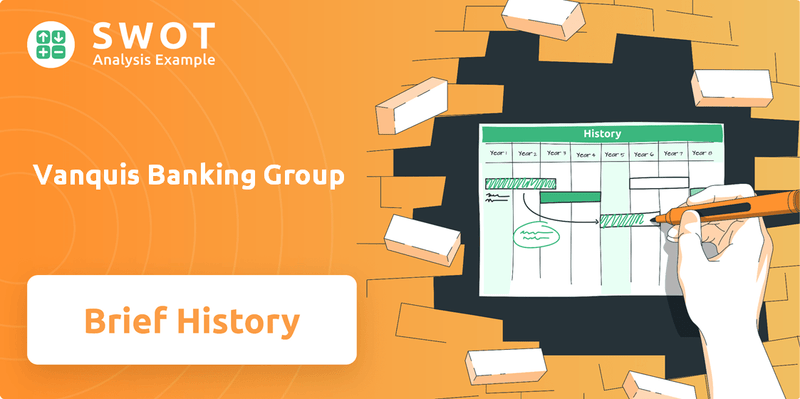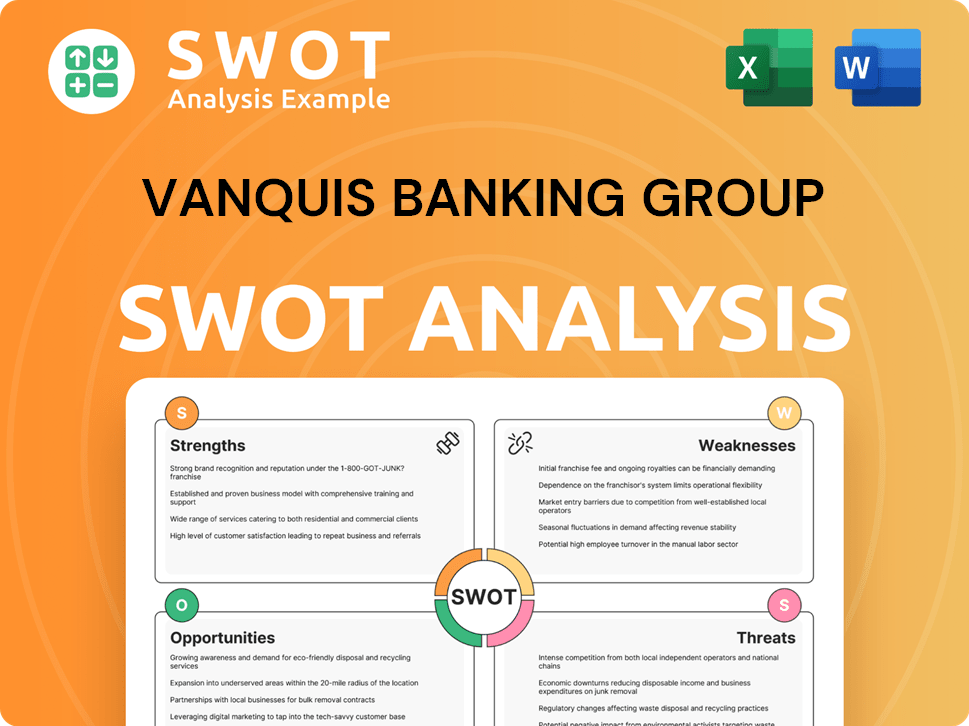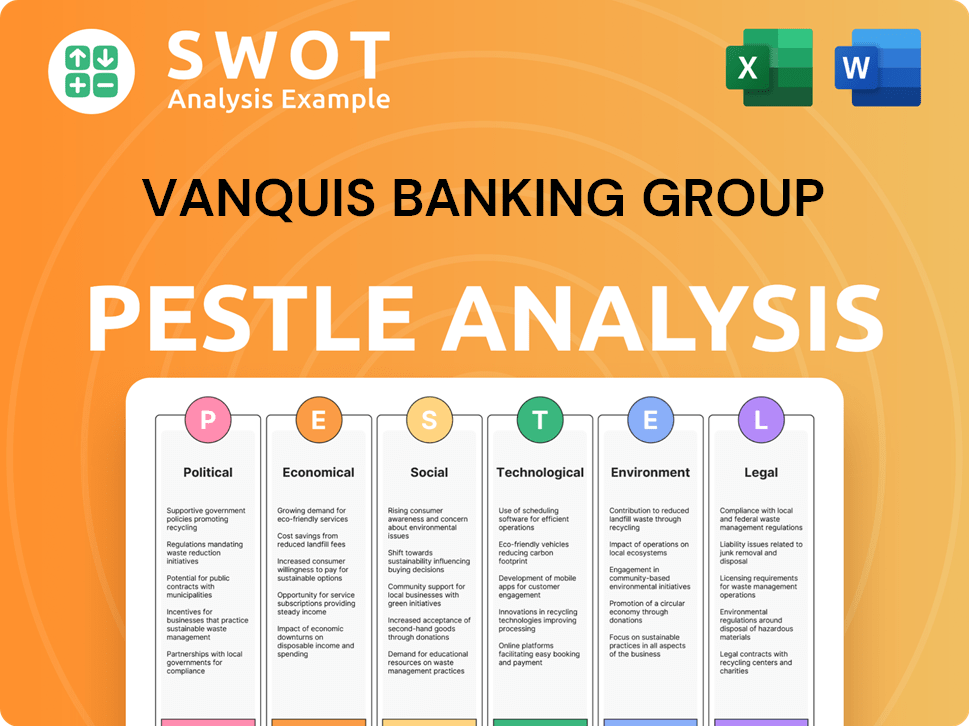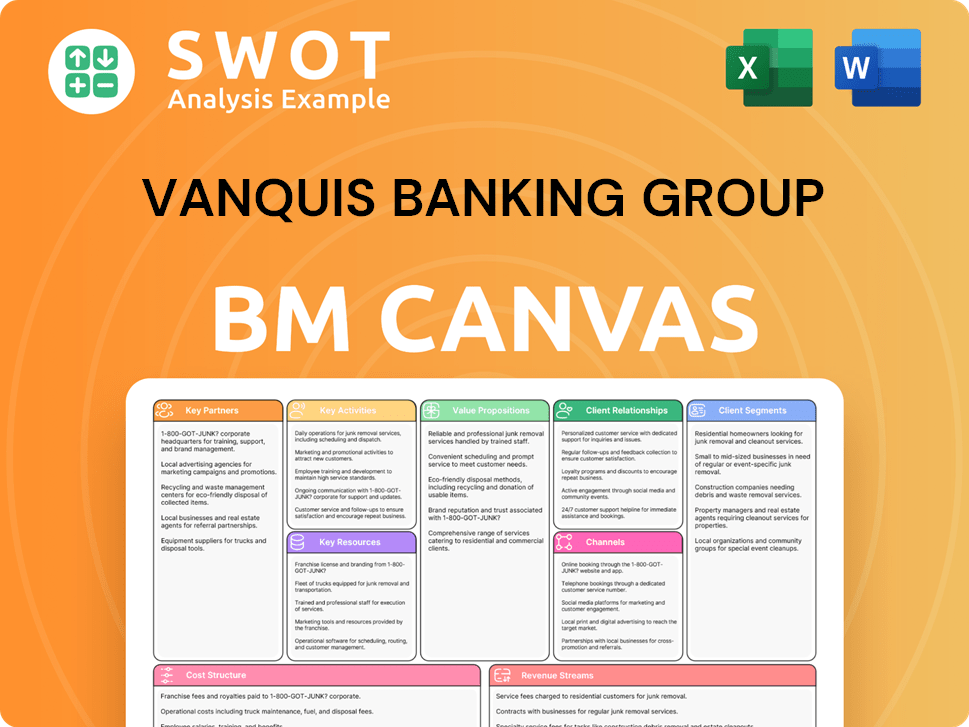Vanquis Banking Group Bundle
How did Vanquis Banking Group rise to prominence in the UK financial sector?
Vanquis Banking Group's story is one of strategic adaptation and a commitment to financial inclusion. Founded in 1996 as Vanquis Bank, a subsidiary of Provident Financial, it identified a crucial need within the UK's financial services landscape. This brief history explores how Vanquis carved a niche by providing credit solutions to underserved individuals, a segment often overlooked by traditional banks.

From its roots in subprime lending, Vanquis Banking Group has expanded its offerings, now serving approximately 1.7 million customers. The Vanquis Banking Group SWOT Analysis offers deeper insights into its strategic positioning. This evolution, from a specialized credit card provider to a leading specialist bank, highlights its resilience and its focus on responsible lending within the UK financial services sector. Understanding the Vanquis Bank history provides valuable context for investors and analysts.
What is the Vanquis Banking Group Founding Story?
The story of Vanquis Banking Group begins with Vanquis Bank, which was established in 1996. It was a venture by Provident Financial plc, a company with roots in sub-prime lending since 1880. The creation of Vanquis Bank was a strategic move to enter the credit card market, focusing on individuals who found it difficult to get credit elsewhere.
The founders of Vanquis Bank recognized a gap in the market. Many people were excluded from mainstream credit, which limited their financial opportunities and participation in the economy. Vanquis aimed to solve this problem by providing credit cards to those with less-than-perfect credit histories.
The initial funding for Vanquis Bank came from Provident Financial, leveraging its existing financial resources and expertise in understanding the needs of underserved customers. This internal funding allowed Vanquis to develop its specialized offerings. The mid-1990s saw growing demand for consumer credit and increased awareness of financial exclusion, creating a favorable environment for Vanquis Bank's approach. To learn more about the company's operations, consider reading about the Revenue Streams & Business Model of Vanquis Banking Group.
Vanquis Bank was founded in 1996 by Provident Financial.
- It targeted the sub-prime credit market.
- The initial funding came from its parent company, Provident Financial.
- The business model focused on providing credit cards to those with limited credit options.
- The company aimed to help customers manage finances and improve credit scores.
Vanquis Banking Group SWOT Analysis
- Complete SWOT Breakdown
- Fully Customizable
- Editable in Excel & Word
- Professional Formatting
- Investor-Ready Format

What Drove the Early Growth of Vanquis Banking Group?
The early growth of Vanquis Banking Group, formerly known as Vanquis Bank, was marked by a steady increase in its credit card customer base, indicating strong demand for its specialized financial products. In the early 2000s, the company established itself as a leading provider of credit cards for the near-prime and sub-prime markets. Key strategies involved refining credit assessment models to manage risk while serving its target demographic. By 2007, Vanquis Bank had reached a significant milestone, with one million customers.
Vanquis Bank's focus on the subprime lending market allowed it to capture a significant customer base. This expansion was supported by effective risk management and customer service. The company's ability to cater to underserved segments of the UK financial services market was crucial to its growth. The sustained growth is a testament to its customer-centric approach.
In 2013, Vanquis expanded its product offerings beyond credit cards by launching personal loans. This diversification helped to address a broader range of customer financial needs. The introduction of personal loans allowed Vanquis to capture additional revenue streams. This strategic move demonstrated a deeper understanding of its customer base.
As of 2023, Vanquis Banking Group reported a total customer base of approximately 1.7 million. The average net loan book stood at around £1.6 billion, reflecting strong financial performance. The company's success is supported by its ability to adapt to the competitive financial landscape. These figures highlight the company's sustained growth and market presence.
Vanquis Bank's commitment to responsible lending practices played a crucial role in its growth. This approach helped build trust among its customer base and ensure regulatory compliance. The focus on responsible lending also mitigated risks associated with subprime lending. These practices have been essential to maintaining a sustainable business model.
Vanquis Banking Group PESTLE Analysis
- Covers All 6 PESTLE Categories
- No Research Needed – Save Hours of Work
- Built by Experts, Trusted by Consultants
- Instant Download, Ready to Use
- 100% Editable, Fully Customizable

What are the key Milestones in Vanquis Banking Group history?
The journey of Vanquis Banking Group has been marked by significant milestones, innovations, and challenges within the UK financial services sector. The company's evolution reflects its strategic adaptation to market dynamics and regulatory changes, solidifying its position in the subprime lending market. Understanding the Vanquis Bank history provides crucial context for its current operations and future prospects.
| Year | Milestone |
|---|---|
| Early 2000s | Launch of Vanquis credit cards, establishing a foothold in the specialist credit market. |
| 2013 | Expansion into personal loans, diversifying its product offerings and customer base. |
| 2014 | Acquisition of Moneybarn, entering the vehicle finance market and broadening its lending portfolio. |
| 2021 | Demerger from Provident Financial, becoming an independent listed entity and focusing on specialist banking operations. |
| 2023 | Continued focus on digital transformation and customer service enhancements to improve operational efficiency. |
A key innovation for Vanquis Banking Group was its early adoption of data-driven credit assessment models, enabling responsible lending to customers often excluded by mainstream banks. This approach allowed the company to develop tailored products, such as Vanquis credit cards, designed to help customers improve their credit scores.
Early implementation of advanced credit scoring models to assess risk and make informed lending decisions, a core element of the Vanquis Bank history.
Development of financial products, including Vanquis credit cards, specifically designed to meet the needs of customers with less-than-perfect credit histories.
Acquisition of Moneybarn in 2014, expanding the product portfolio and market reach within the UK financial services sector.
Ongoing investments in digital platforms and online banking services to improve customer experience and operational efficiency.
Like many financial institutions, Vanquis Banking Group has faced challenges related to regulatory compliance and economic downturns. The company has also addressed issues related to customer treatment and lending practices, leading to continuous improvements in its operations. For more details about the company's core values, you can read about the Mission, Vision & Core Values of Vanquis Banking Group.
Navigating evolving regulations concerning consumer credit and responsible lending, a continuous focus for Vanquis Banking Group.
Adapting to changes in consumer spending and economic conditions, requiring agile adjustments to risk appetite and product offerings.
Enhancing customer service and complaint handling procedures to improve customer satisfaction and address past criticisms.
Facing competition from both traditional banks and fintech companies within the UK financial services market, requiring continuous innovation.
Vanquis Banking Group Business Model Canvas
- Complete 9-Block Business Model Canvas
- Effortlessly Communicate Your Business Strategy
- Investor-Ready BMC Format
- 100% Editable and Customizable
- Clear and Structured Layout

What is the Timeline of Key Events for Vanquis Banking Group?
The Vanquis Banking Group has a history rooted in providing financial services to underserved customers. Launched in 1996 by Provident Financial plc, the company initially focused on offering credit cards. Over the years, it expanded its offerings and customer base, facing challenges and ultimately becoming an independent entity. Key milestones include reaching one million customers in 2007, diversifying with personal loans in 2013, and acquiring Moneybarn in 2014. The demerger from Provident Financial plc in 2021 marked a significant shift, positioning it as a standalone company on the London Stock Exchange. By 2023, the group reported a customer base of 1.7 million and an average net loan book of £1.6 billion, reflecting its continued presence in the UK financial services sector, particularly in subprime lending.
| Year | Key Event |
|---|---|
| 1996 | Vanquis Bank was launched by Provident Financial plc, providing Vanquis credit cards to underserved customers. |
| 2007 | Vanquis Bank reached one million customers, demonstrating early growth in the subprime lending market. |
| 2013 | The introduction of personal loans broadened the product offerings, diversifying the financial services provided. |
| 2014 | Acquisition of Moneybarn marked an entry into the vehicle finance market. |
| 2017 | Provident Financial Group faced challenges in its consumer credit division. |
| 2021 | Vanquis Banking Group demerged from Provident Financial plc, becoming an independent entity. |
| 2023 | Reported a total customer base of 1.7 million and an average net loan book of £1.6 billion. |
| 2024 | Focus on digital transformation and expanding its product suite. |
Vanquis Banking Group is heavily investing in digital capabilities. This includes enhancements to mobile banking platforms and the use of data analytics. These improvements aim to personalize product offerings and improve customer experiences. The strategy aligns with the ongoing shift towards digital financial services in the UK.
The company plans to expand its product portfolio. This includes exploring new areas within specialist lending. This is done while maintaining a focus on responsible lending practices. The goal is to offer more flexible credit solutions to a wider customer base.
Vanquis Banking Group is committed to supporting financial inclusion. It aims to help customers improve their financial health. This commitment is consistent with its founding vision of serving those overlooked by mainstream financial institutions. This approach is adapting to a rapidly evolving digital landscape.
The company is focused on sustainable growth. It aims for a return on tangible equity of at least 10% in the medium term. This strategic outlook is influenced by increasing demand for flexible credit solutions. The company's goal is to balance growth with responsible financial practices.
Vanquis Banking Group Porter's Five Forces Analysis
- Covers All 5 Competitive Forces in Detail
- Structured for Consultants, Students, and Founders
- 100% Editable in Microsoft Word & Excel
- Instant Digital Download – Use Immediately
- Compatible with Mac & PC – Fully Unlocked

Related Blogs
- What is Competitive Landscape of Vanquis Banking Group Company?
- What is Growth Strategy and Future Prospects of Vanquis Banking Group Company?
- How Does Vanquis Banking Group Company Work?
- What is Sales and Marketing Strategy of Vanquis Banking Group Company?
- What is Brief History of Vanquis Banking Group Company?
- Who Owns Vanquis Banking Group Company?
- What is Customer Demographics and Target Market of Vanquis Banking Group Company?
Disclaimer
All information, articles, and product details provided on this website are for general informational and educational purposes only. We do not claim any ownership over, nor do we intend to infringe upon, any trademarks, copyrights, logos, brand names, or other intellectual property mentioned or depicted on this site. Such intellectual property remains the property of its respective owners, and any references here are made solely for identification or informational purposes, without implying any affiliation, endorsement, or partnership.
We make no representations or warranties, express or implied, regarding the accuracy, completeness, or suitability of any content or products presented. Nothing on this website should be construed as legal, tax, investment, financial, medical, or other professional advice. In addition, no part of this site—including articles or product references—constitutes a solicitation, recommendation, endorsement, advertisement, or offer to buy or sell any securities, franchises, or other financial instruments, particularly in jurisdictions where such activity would be unlawful.
All content is of a general nature and may not address the specific circumstances of any individual or entity. It is not a substitute for professional advice or services. Any actions you take based on the information provided here are strictly at your own risk. You accept full responsibility for any decisions or outcomes arising from your use of this website and agree to release us from any liability in connection with your use of, or reliance upon, the content or products found herein.